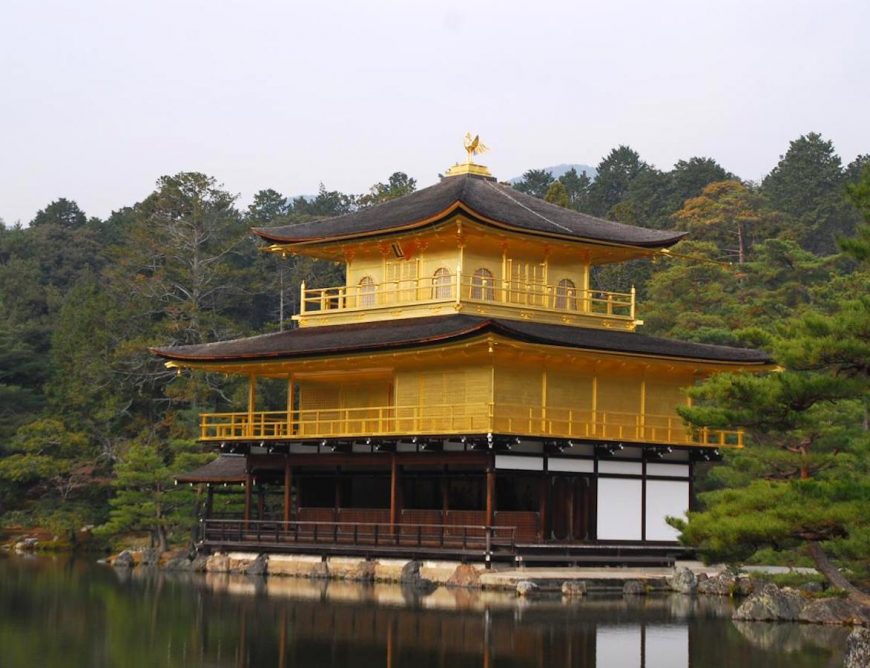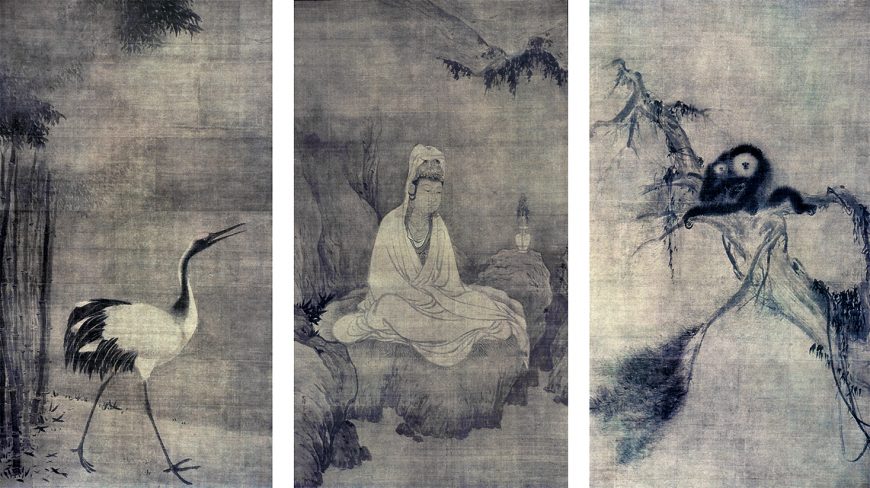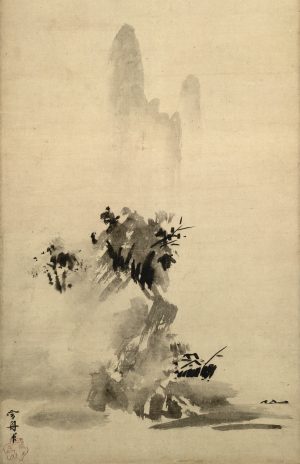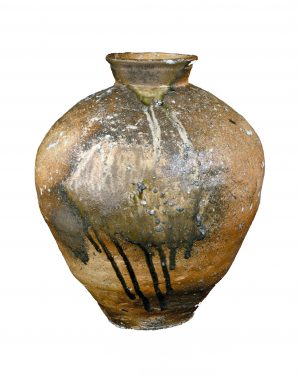Nanbokuchō (1333–1392) and Muromachi (1392–1573) periods: Zen principles, ink painting, and elegant beauty
The Muromachi period, coinciding with the rule of Ashikaga shōguns, was one of the most turbulent and violent in Japanese history. It started with the Nanbokuchō (“the period of the southern and northern courts”), during which political power was split between the Ashikaga-controlled “northern” court and the “southern” and short-lived court of emperor Go-Daigo. The Muromachi period also included the Sengoku (“the age of the country at war”), a period of warfare and chaos in the aftermath of the Ōnin war (1467-1477), triggered by rivalry between provincial warlords.

Zen Buddhist temple Rokuonji, commonly known as Kinkakuji/ Golden Pavilion, originally a villa, first built 1397, reconstructed 1955 (Kyoto, image: Foto Captor, CC BY-NC-ND 2.0)
Two of the Ashikaga shōguns, Yoshimitsu (14th century) and Yoshimasa (15th century), are associated with the Kitayama and Higashiyama cultures, respectively—two sub-periods of cultural efflorescence that nurtured important developments in Japanese arts across mediums. Kitayama culture, so named after an area north of Kyoto where Ashikaga Yoshimitsu had a golden pavilion—Kinkakuji 金閣寺—built for his retirement, is known for the emergence of Noh and the increased influence of Zen Buddhism and Chinese ink painting.
Art coming from contemporaneous Ming-dynasty China as well older Chinese art—dating from the Song and Yuan dynasties, such as the works of Muqi (Mokkei 牧谿 in Japanese)—deeply influenced Japanese arts, especially the emerging local tradition of ink landscape painting.

Muqi (active 13th century), Kannon framed by Crane and Gibbons, three hanging scrolls, ink and light color on silk, 174.2 cm x 98.8 cm (Kannon). Japanese artists like Hasegawa Tōhaku, who traced their stylistic roots to Sesshū, had opportunities to study these paintings at a Buddhist temple in Kyoto where they have been housed for centuries (Daitokuji)
The most influential Japanese ink master, the 15th-century painter and Zen monk Sesshū Tōyō combined, in his works, Zen principles and lessons learned from Song-dynasty Chinese ink painting—most notably a double sense of austerity and immediacy, highly admired by the Ashikaga shōguns and the samurai class who embraced Zen Buddhism.

Sesshū, Splashed-Ink Landscape (or Broken-Ink Landscape, haboku sansui zu破墨山水図), 1495, ink on paper, 148.6 × 32.7 cm (full scroll) (Tokyo National Museum, image: Wikimedia Commons)
Sesshū was a celebrated artist in his own lifetime and continued to be revered as a model by later generations of painters. He became a Zen Buddhist monk at a young age and his master taught him both about Zen and about Chinese ink painting. To perfect his understanding of both, Sesshū traveled to China, where he was honored as a distinguished guest. It is believed that he painted in both palatial and monastic contexts. Upon his return to Japan, he laid the foundation for a new era of Japanese ink painting that straddled religious and lay patronage and combined Chinese and Japanese stylistic elements.
Over the centuries, painters emulated Sesshū’s style, especially his “splashed ink” or “broken ink” technique, and its roots in the literati tradition, some even affixing the painter’s seal to their works, all in an attempt to follow into the footsteps of a revered artist and to attract patrons. The Unkoku school strategically considered its painters to be in the direct lineage of Sesshū. The Hasegawa school similarly traced its stylistic genealogy to Sesshū. These two schools are just two of many examples of Japanese artists embracing a stylistic lineage, whether real or construed, leading back to Sesshū or another master. Legitimizing genealogies are a hallmark of Japanese art history.
The advancement of ink painting under the influence of Sesshū is part and parcel of the second Ashikaga-patronized sociocultural sub-period—the so-called Higashiyama culture, named after an area east of Kyoto, where the shōgun Ashikaga Yoshimasa had a silver pavilion—Ginkakuji 銀閣寺—built for his retirement.
The Higashiyama culture entailed programmatic patronage of the arts. During this period, the Kanō school of painting is established and its founder, Masanobu, is appointed official shogunal painter in the late 15th century. At this early stage, Kanō school painting is particularly indebted to Chinese ink painting and the Chinese bird-and-flower tradition. Masanobu’s son, Kanō Motonobu, widened the school’s painting repertoire by introducing color and indigenous motifs and thereby laid the foundation for an appealing synthesis of Chinese and Japanese elements.

Kano Motonobu, Birds and Flowers of the Four Seasons, 16th century, pair of folding screens, ink, color, and gold on paper, 162.4 × 360.2 cm each (Hakutsuru Fine Art Museum, Kobe)
The imperial court had its own favored line of painters, who worked in the yamato-e tradition and often specialized in pictures drawn from the Tale of Genji. (Both yamato-e and the Tale of Genji are described in the section on Heian-period art.) These painters are known as the Tosa school; the earliest mention of a painter named Tosa dates from the early 15th century and refers to a painter who was also the governor of the Tosa province. Contemporaneous with the beginnings of the Kanō school was Tosa Mitsunobu, who expanded his school’s repertoire much like Kanō Motonobu did for his school, except in opposite directions: while the Kanō artist added elements of traditional Japanese painting, the Tosa artist began to incorporate elements of Chinese painting. In this sense, the two schools created separate versions of a Chinese-Japanese stylistic synthesis, with the Tosa relying more heavily on the Japanese tradition and the Kanō, on the Chinese.

Storage jar, 14th–15th century, stoneware with natural ash glaze, Shigaraki, 46.7 cm high (The Metropolitan Museum of Art)
At the same time, the tea ceremony (chanoyū 茶の湯) emerged as a ritualized form of preparing and enjoying powdered green tea. For this ritual, domestic ash-glazed stoneware vessels, coiled by hand and fired in wood-burning kilns, began to be favored for their austere elegance or sense of sabi 寂—an important Japanese aesthetic concept that stands for seeking beauty in what is simple, solitary, and withered.
These different art forms and mediums—painting, ceramics, dramatic performances, collaborative poetry-writing parties, and tea rituals—converged in shogunal residences like the Golden and Silver Pavilions and especially in the decor of these residences, governed by the aesthetic principle of fūryū 風流—another enduring aesthetic notion in Japan, referring to a refined taste that favors rarified elegance and sensual beauty.
Additional resources:
For information on other periods in the arts of Japan, see the longer introductory essays here:
A brief history of the arts of Japan: the Jomon to Heian periods
A brief history of the arts of Japan: the Kamakura to Azuchi-Momoyama periods
A brief history of the arts of Japan: the Edo period
A brief history of the arts of Japan: the Meiji to Reiwa periods
JAANUS, an online dictionary of terms of Japanese arts and architecture
e-Museum, database of artifacts designated in Japan as national treasures and important cultural properties
On Japan in the Metropolitan Museum of Art’s Heilbrunn Timeline of Art History
Richard Bowring, Peter Kornicki, The Cambridge Encyclopedia of Japan (New York: Cambridge University Press, 1993)

